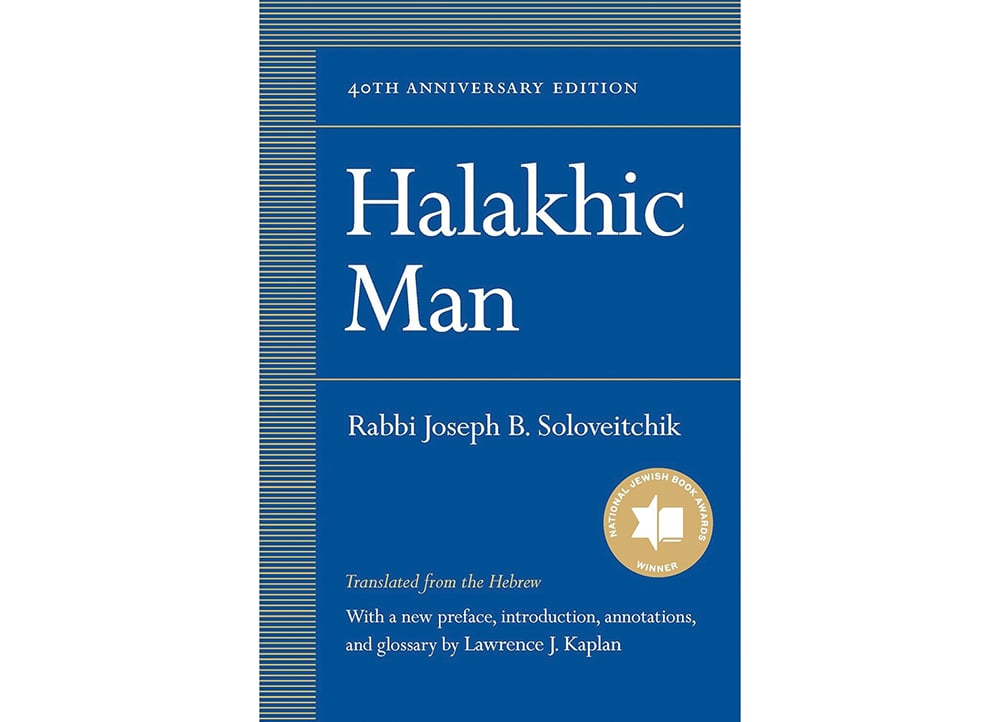
Reviewing: “Halakhic Man” by Rabbi Joseph B. Soloveitchik. The Jewish Publication Society; 40th Anniversary edition. 2023. English. Hardcover. 408 pages. ISBN-13:
978-0827615601.
Some years back, I went to a batting cage where you could have a major-league baseball experience by having the ball pitched at 100 miles per hour. It was, in fact, a scary experience, and none of my swings made contact. Only at about 70 miles per hour could I make minimal contact and get a hit.
That seems to be a good metaphor for my experience with Rabbi Joseph Soloveitchik’s classic work “Halakhic Man.” When I first read it some years ago, I naively thought it was something I could understand, albeit with some work.
In truth, ”Halakhic Man” is a graduate-level work of philosophy. Rav Soloveitchik expects the reader to be conversant in the works of philosophers such as Hermann Cohen, Immanuel Kant, and Ernst Cassirer, along with Greek philosophy, Jewish theology and Talmudic thought.
The Rav will write a paragraph detailing complex concepts and sources at numerous points in the book, leaving the reader with significant work before trying to read ahead.
For example, footnote 4 is famous for its depth, which would likely take the reader months to comprehend all the sources fully. “Halakhic Man” is 137 pages of 100-mile-per-hour fastballs.
The book was first published in Hebrew in 1944 in the Hebrew journal Talpiot. Professor Lawrence Kaplan of the Jewish Studies department at McGill University in Montreal did a masterful job with his English translation in 1983. It was, in parlance, an instant classic and became one of Rav Soloveitchik’s best-known works. But as masterful as Kaplan’s translation was, it was still incredibly complex.
But as complex as it is, and for many a near-impossible book to penetrate, something gravitates people to it. As Rabbi Aryeh Klapper wrote: “I first tried to read Ish ha-Halakhah as a high school student. I didn’t get far—the first or second quote in Greek characters defeated me—but I got far enough that I’ve never been able to escape the gravitational pull of the Rav’s thought.”
The Jewish Publication Society “Halakhic Man: 40th Anniversary Edition” is a new, masterful work. It includes the original text of ”Halakhic Man,” in addition to:
Translator’s (i.e., Professor Kaplan) preface tracing the book’s reception and evolving influence.
Translator’s introduction, shedding light on the heart of Soloveitchik’s argument.
List of errata to the original text.
Translator’s annotations explaining Soloveitchik’s references and underlying teachings.
Glossary of key terms.
Bibliography of works cited in this edition.
Two indexes: an index of biblical and rabbinic sources and an index of names and subjects incorporating the edition’s full content.
These additions significantly assist the reader with this essential yet complex work, adding much-needed context to the overall work.
The book contains two sections, and the goal of the Rav in the first section is to show that a halachic man’s consciousness is torn between the “this-worldly” attitude typifying cognitive man, and the otherworldly attitude characteristic of the homo religious. Cognitive man/homo religious is exemplified by the mathematician or theoretical physicist, who seeks to understand the world by constructing an a priori ideal world and correlating it to the concrete world set firmly within the bounds of time and space.
Many books will conclude with advice or action items on achieving the goals described. But the Rav never directly tells the reader how exactly to become a halachic man. In the new introduction, Kaplan writes that the process would appear to be an intriguing, if unstable, blend of halachic, Aristotelian, and neo-Kantian elements.
The Rav writes that the halachic man recognizes no authority other than the authority of the intellect, obviously in accordance with the principles of tradition. Not exactly an easy goal. And the Rav creates a construct for an individual that would seem almost impossible to achieve. And in fact, some people wouldn’t want to be a halachic man as he describes it.
For instance, notions such that a halachic man is not overly curious or is not concerned about the possibility of actualizing the halacha in the concrete world would be foreign to many.
Lest the reader thinks that the halachic man, as the Rav described it, is a cold and calculated robot, in a critique of the Mussar movement, he writes that the Torah cannot be acquired in a state of melancholia and depression. And that while halachic man will not dance in the streets on Passover night, nor will he shout out his prayers during the Days of Awe, this is not to say that he is not inspired and excited by sacred time or that he is lacking in a powerful religious experience.
If anything, this book is a testament to the Rav—his utter and complete mastery of modern and ancient philosophy, both classical physics and quantum mechanics, to Shas, poskim and Jewish philosophy. And his ability to integrate all of them into a 137-page work is an act of unique brilliance.
In ”Mentor of Generations: Reflections on Rabbi Joseph B. Soloveitchik” (Ktav), Rabbi Dr. Zev Eleff writes how the Rav was a terror during shiur in his early years. He expected his students to be wholly prepared and conversant in the prepared topic. And those who were not up to the task were often left devastated. In ”Halachic Man,” it is the Rav at his most demanding level.
Kaplan has done a tremendous service to the Rav’s legacy in making one of his most important works much more understandable to those who, like Rabbi Klapper, not only want to feel the gravitational pull of the Rav’s thought, but to actually understand those thoughts as well.
Ben Rothke lives in New Jersey and works in the information security field. He reviews books on religion, technology, philosophy and science. Follow him on Twitter at @benrothke. His new book was just published: “The Definitive Guide to PCI DSS Version 4: Documentation, Compliance, and Management.”












